Showing all 34 results
-
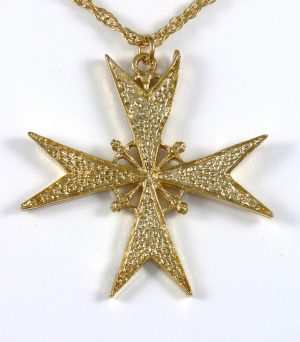
18 carat Gold plated Cross of a Knight of Malta
£34.50It belonged to Fabricio Spinola of Genoa. He was Captain of the Girona, one of the Galleas of the Spanish Armada, which was sent by Philip II ofSpain to attack Britain in 1588. A Galleas was a hybrid of oars and sail. The ships were dispersed first by the British fire ships then by…
-
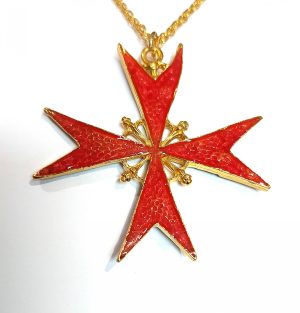
18 carat Gold plated Cross of a Knight of Malta with blood red enamel
£49.95This cross belonged to Fabricio Spinola of Gerona. He was Captain of the Girona, one of the Galleas of the Spanish Armada, sent by Philip II of Spain to attack Britain in 1588. A Galleas was a hybrid of oars and sail. The ships were dispersed first by the British fire ships then by a…
-
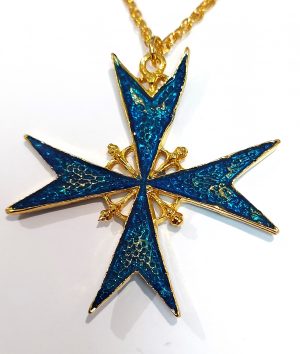
18 carat Gold plated Cross of a Knight of Malta with blue enamel
£49.95The cross belonged to Fabricio Spinola of Genoa. He was Captain of the Girona, one of the Galleas of the Spanish Armada, which was sent by Philip II of Spain to attack Britain in 1588. A Galleas was a hybrid of oars and sail. The ships were dispersed first by the British fire ships then…
-
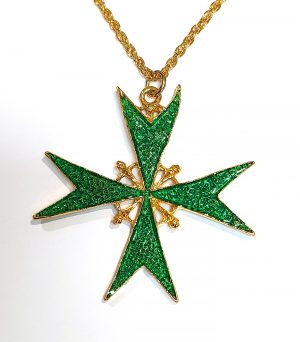
18 carat Gold plated Cross of a Knight of Malta with green enamel
£49.95The cross belonged to Fabricio Spinola of Genoa. He was Captain of the Girona, one of the Galleas of the Spanish Armada, sent by Philip II of Spain to attack Britain in 1588. A Galleas was a hybrid of oars and sail. The ships were dispersed first by the British fire ships then by a…
-
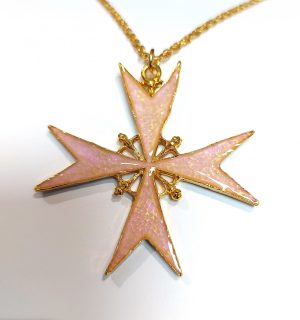
18 carat Gold plated Cross of a Knight of Malta with pearlescent enamel
£49.95This cross belonged to Fabricio Spinola of Genoa. He was Captain of the Girona, one of the Galleas of the Spanish Armada, sent to attack Britain in 1588. A Galleas was a hybrid of oars and sail. The ships were dispersed first by the British fire ships and then by a storm that sent them…
-
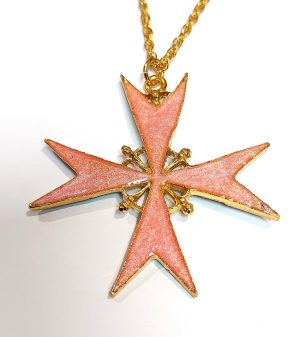
18 carat Gold plated Cross of a Knight of Malta with pink enamel
£48.00This cross belonged to Fabricio Spinola of Genoa. He was Captain of the Girona, one of the Galleas of the Spanish Armada, sent by Phiolip II of Spain to attack Britain in 1588. A Galleas was a hybrid of oars and sail. The ships were dispersed first by the British fire ships then by a…
-
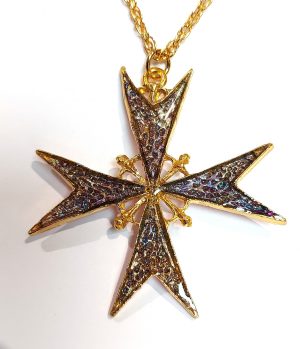
18 carat Gold plated Cross of a Knight of Malta with Purple/blue enamel
£49.95This cross belonged to Fabricio Spinola of Genoa. He was Captain of the Girona, one of the Galleas of the Spanish Armada, sent to attack Britain in 1588. A Galleas was a hybrid of oars and sail. The ships were dispersed first by the British fire ships then by a storm that sent them up…
-
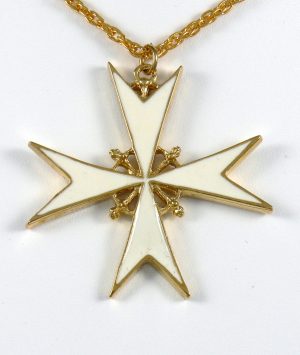
18 carat Gold plated Cross of a Knight of Malta with white enamel
£43.00It belonged to Fabricio Spinola of Genoa. He was Captain of the Girona, one of the Galleas of the Spanish Armada, which was sent by Philip II of Spain to attack Britain in 1588. A Galleas was a hybrid of oars and sail. The ships were dispersed first by the British fire ships then…
-
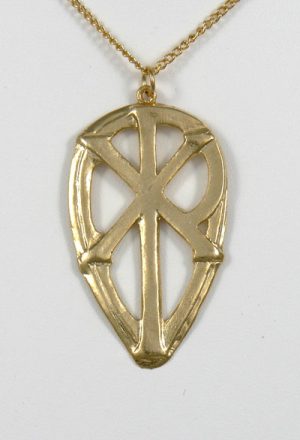
Chi Rho Pendant
£31.00Detail taken from a bronze pew decoration in the parish church at Dodington House, Gloucester. It is the family seat of Major Codrington. The Greek monogram Chi Rho is composed of the first two letters of the Greek word XPICTOC, meaning Christ. Height 46mm
-
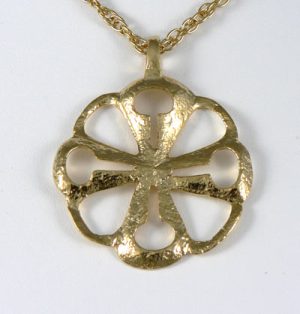
Cruciform Harness Pendant
£36.5012th – 13th century AD. The gilded bronze (ormolu) original with a repousse pierced cruciform design was excavated at Old Sarum,. Salisbury Museum, Wiltshire. Width 42mm
-
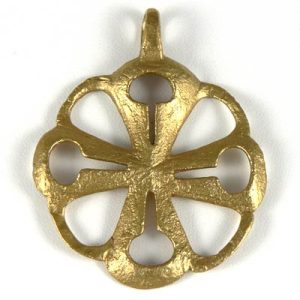
Cruciform Harness Pendant
POA (Price On Application)12th – 13th century AD. The gilded bronze (ormolu) original with a repousse pierced cruciform design was excavated at Old Sarum,. Salisbury Museum, Wiltshire. Width 42mm. 9 carat yellow gold, supplied on a 20″ gold chain.
-
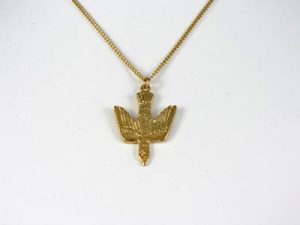
Dove descending
£28.00Dove descending. 11th century AD. Modelled on an 11th century manuscript illustration. Following the account of the Baptism of Christ, (Matthew 3:16, etc.). From the illustration of the dove descending to the King David. Psalter (BS. 1 Beatus). British Library Mss. Cotton. Tiberius C.VI, f. 30v. Height 32mm
-
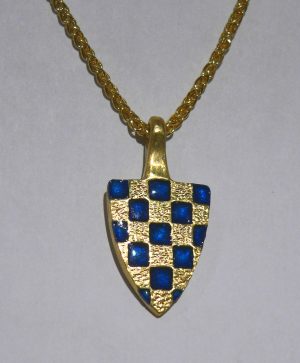
Earl of Surrey Horse Harness pendant
£347.00This Silver/gilt pendant has been modelled on a 14th Century bronze and enamel horse harness pendant decoration bearing the arms of the Earl de Warenne.
-
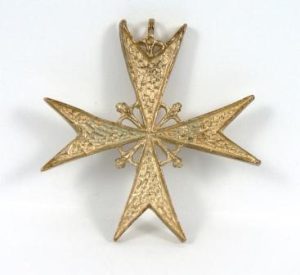
Gold Cross of a Knight of Malta
POA (Price On Application)It belonged to Fabricio Spinola of Genoa. He was Captain of the Girona, one of the Galleas of the Spanish Armada, which was sent by Philip II of Spain to attack Britain in 1588. A Galleas was a hybrid of oars and sail. The ships were dispersed first by the British fire ships then by…
-
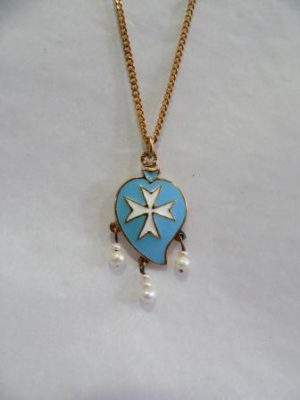
Knights of St. John enamel heart pendant
£53.40Heart shaped enamel pendant with the cross of the Order of the Knights of St. John. The original gold heart-shaped pendant, with the cross of the Knights of St John, turquoise and white enamel, with seed pearls, is from the 1 7th century. Height 32mm Museum of the Order of St John . Clerkenwell, London.
-
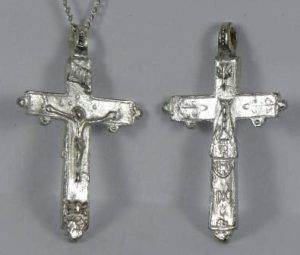
Lihou Island Crucifix
£270.25Lihou Island Crucifix. 16th century AD. The bronze original was found by F>C> Lukis, a noted antiquarian, during his excavations of the priory in 1838. Lihou Island, connected to Guernsey by an ancient causeway, is the smallest inhabited Channel Island. Lihou Priory, now in ruins, flourished from mid-12th to mid-16th century, as a daughter house…
-
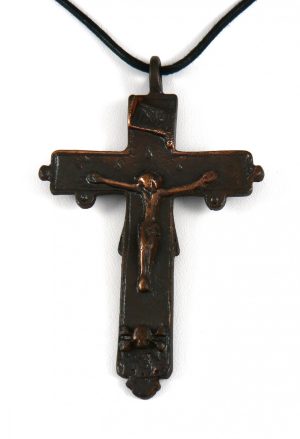
Lihou Island Crucifix
£43.50Lihou Island Crucifix. 16th century AD. The bronze original was found by F>C> Lukis, a noted antiquarian, during his excavations of the priory in 1838. Lihou Island, connected to Guernsey by an ancient causeway, is the smallest inhabited Channel Island. Lihou Priory, now in ruins, flourished from mid-12th to mid-16th century, as a daughter house…
-
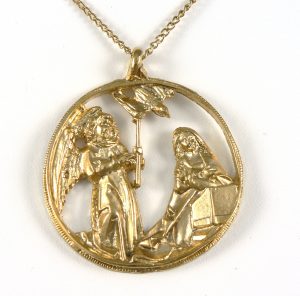
Mediaeval Annunciation Pendant
£29.95The silver-gilt original is the obverse of a pendant and depicts the Annunciation which was a favourite devotional motif in the late Middle Ages. Possibly used as a rosary ornament. German, 15th century AD. V&A London. Diameter 43mm.
-
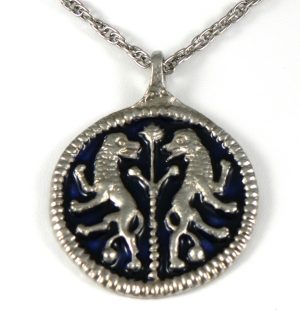
Mediaeval enamelled Harness Pendant
£31.50The silvered bronze original has the repousse design of a plant between two lions endorsed regardent, as found on the seal of Countess Ela. Excavated at Old Sarum. 13th century AD. Salisbury Museum. Diameter 40mm.
-
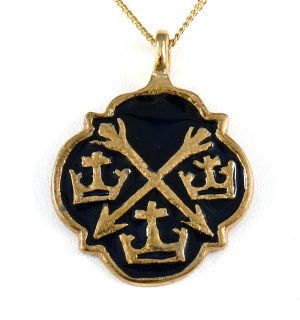
Mediaeval Horse Harness Pendant
£32.25The bronze and enamel original bears the arms of St. Edmund. It would have been used by a retainer to show he belonged to the Abbey of Bury St. Edmunds. Moyse's Hall Museum, Bury St. Edmunds, Suffolk. Width 31mm.
-
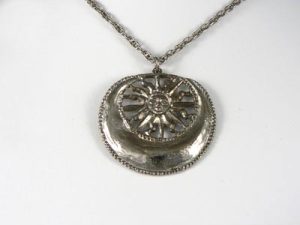
Mediaeval Livery Badge
£29.95Mediaeval Livery Badge. 14th-15th century AD. The lead original depicts the sun in a crescent moon. It is possibly a badge of the Daunger family and was found in Salisbury in 1852. Salisbury Museum, Wiltshire. Width 45mm
-
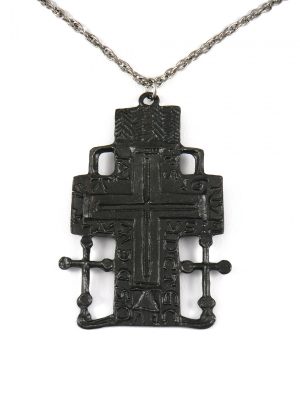
Mediaeval Pilgrim Badge Pendant
£33.22Originally cast from the Mediaeval stone mould of a souvenir sold to visitors to the shrine of the Holy Cross of Waltham (Waltham Abbey). The inscription reads + Signum Sanct Crucis de Waltham. 12th century AD. Museum of London. Length 70mm, width 45mm.
-
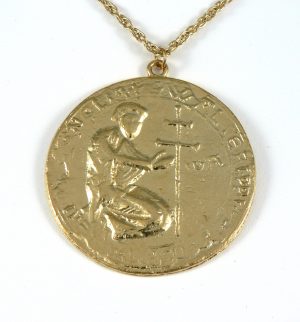
Mediaeval Seal of Walter
£31.00Walter, the first Grand Prior of the Order of St. John in England (1144 – 62) is shown kneeling in adoration before a patriarchal cross. 1148 AD. Order of St. John Museum, Clerkenwell, London. Diameter 51mm
-
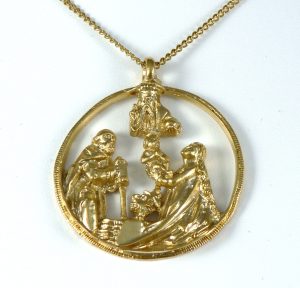
Nativity Pendant
£29.00Mediaeval German Nativity Pendant. The silver-gilt original is the reverse of a pendant that depicts the Nativity which was one of the principle mysteries of Late Middle Ages religion. V&A London. Diameter 43mm.
-
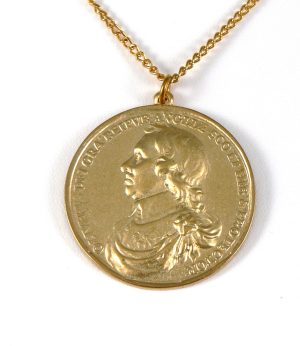
Oliver Cromwell medal
£26.45From 1599 – 1658 AD, this medal is thought to have been an official Protectorate reward for political or military service. The 1740 cast is very rare and may be seen in the Cromwell Museum, Huntingdon, Cambridgeshire. Diameter 36mm.
-
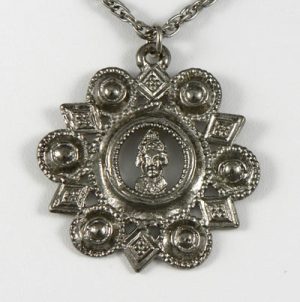
Pilgrim Badge Pendant
£34.5014th century AD. The lead original depicts St, Thomas of Canterbury. Recovered from the Thames at Dowgate.Museum of London, London Wall. Diameter 42mm
-
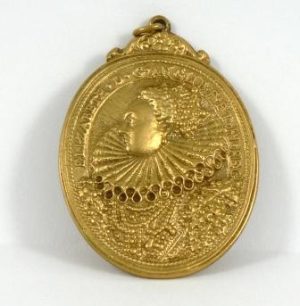
Queen Elizabeth’s Armada Medal
POA (Price On Application)Queen Elizabeth’s Armada Medal. AD 1589. Also called ‘Dangers Averted’ Medal. The bronze original commemorates the defeat of the Spanish Armadain 1588. On the reverse is a Bay tree, depicting England, its inscription meaning ‘Not even perils touch it’. National Maritime Museum, London. Height 60mm. This example is made in 9 carat gold and is…
-
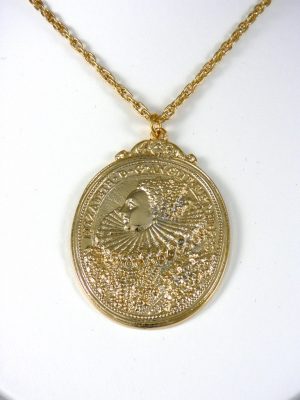
Queen Elizabeth’s Armada Medal
£41.00Queen Elizabeth's Armada Medal circa 1589. Also called 'Danger's Averted' Medal. The bronze original commemmorates the defeat of the Spanish Armada in 1588. On the reverse is a Bay tree, depicting England, its inscription meaning 'Not even perils touch it'. National Maritime Museum, London. Height 60mm.
-
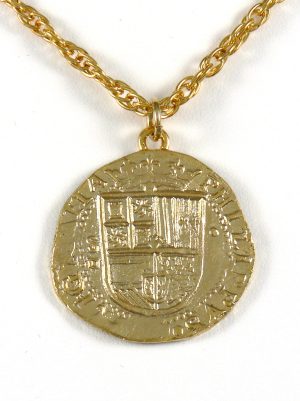
Spanish Gold Four Escudos of Philip II.
£27.00Spanish Gold Four Escudos of Philip II. Circa 1560 – 80. Struck at the Seville Mint. The gold original was recovered from the wreck of the Girona, a galleass af the Spanish Armada, sunk off the Irish coast in 1588. Obverse : crowned royal arms of Philip II of Spain, inscribed PHILIP-PVS GRATIA; reverse :…
-
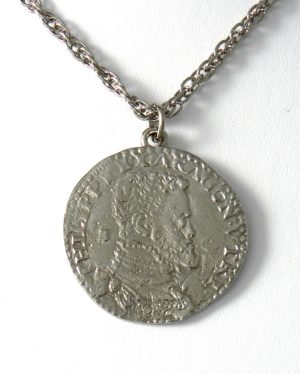
Spanish Silver Half-Ducat Pendant
£26.50Spanish Silver Half-Ducat of Philip II, Circa 1560 – 70 AD, struck for Naples and Sicily. The silver original was recovered from the wreck of the Girona. Obverse: bare-headed bust of Philip II wearing armour. Inscribed PHILIPP REX ARAGON. VTRI. Reverse: crowned royal arms of Philip II of Spain in garnished escutcheon; inscription continues :…
-
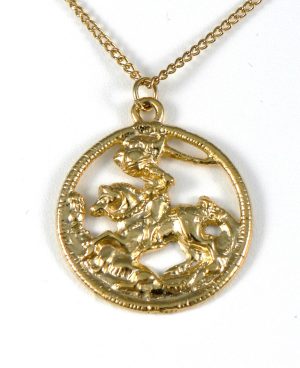
St. George Pendant
£32.00The silver-gilt original depicts St. George, a favourite saint of knights and nobles in the late Middle Ages. Pendants of this kind were often worn hanging from Paternosters and Rosaries. 15th century AD. V&A, London. Diameter 31mm.
-
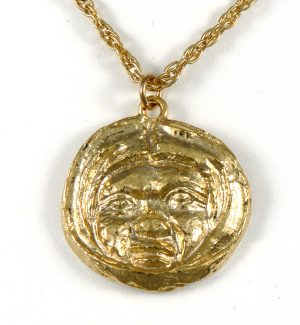
St. William Shrine Pendant
£27.50Pendant based on a face on the shrine of St. William, Archbishop of York. The carved magnesium limestone original is from a figure of a crossbowman. 14th century AD. Yorkshire Museum, York. Width 35mm.
-
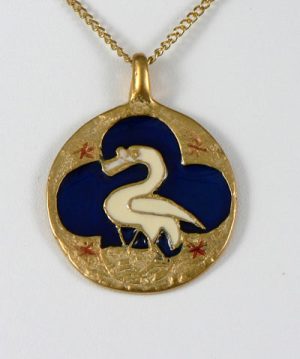
Swan Pendant
£30.38Late 15th century AD. The bronze original, decorated with enamel may have belonged to a retainer of Margaret Beaufort, mother of Henry VII who held Tattershall Castlefrom 1487 to 1509. Found in Tattershall High Street, it is from a horse harness. The swan was a badge of Lancastrian supporters. City Museum, Lincoln. D33
-
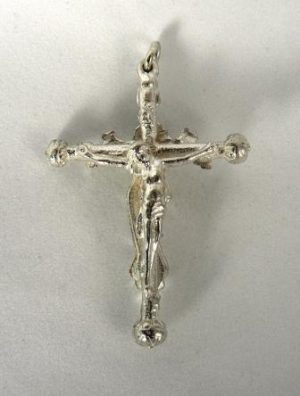
Wolsingham Cross
£450.00The Wolsingham Cross. Early 16th century AD. The silver original is English or Flemish with applied figures. Obverse, Christ crucified, Reverse, the Virgin Mary. Found at chapel walls, Wolsingham. Now in the Cathedral Treasury, Durham. Solid sterling silver, supplied on a 20" silver chain. Height 58mm
